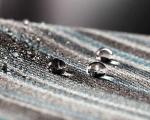Paper narcissus in a simple way: step by step photo instruction.
We present you a master class in which we will tell you how to make daffodils from corrugated paper with your own hands. Such a flower is very easy to make, and a step-by-step instruction with a photo and a detailed description will sufficiently explain how to make it correctly.
Tools and materials Time: 2 hours Difficulty: 5/10
- high-quality double-sided crepe paper in bright orange and grass green;
- crepe paper yellow or white (for petals);
- printed template for flower details (shown below). The three lines in the pattern indicate the direction of the crepe stripes;
- wire cutters;
- scissors;
- ready stamens with red heads;
- glue gun and glue sticks;
- floral wire;
- thin wire;
- ruler.
Daffodils are exclusively spring plants that delight with their flowering for only a few weeks a year. So why not make your own chic crepe paper daffodils to bloom for you all year round?

Paper daffodils are a chic decoration for a theme party, home decor and a great gift for loved ones on the occasion of the holidays!
Materials:

Sample:

Step by step instructions with photo
Let's start making crepe paper daffodils.
Step 1: print the template
Print out the template on heavy A4 paper or card stock and cut out the pieces.
Step 2: cut out the center
- Take the center template and orange crepe paper. Fold the orange crepe in half and attach the template to it. Cut out the template. Cut the top part of the middle with scissors in a zigzag pattern.
- Expand the workpiece. Glue it in the shape of a cylinder. When the glue dries, give the middle a tube shape.
- With your thumb and forefinger, stretch the top of the tube in different directions, giving it a wave shape.

Step 3: cut out the petals
- Next, cut out the petals. To do this, take a piece of yellow crepe paper along the length of the petal from the template and fold it like an accordion 5 times. Attach the template to the folded crepe and cut out 6 neat petals. Make sure the direction of the crepe strips follows the pattern.
- Using scissors, slightly bend the petals down, giving them an arc shape.
- With your thumb and forefinger, slightly stretch the middle part of the petals to the sides. This will give them a more natural look.
- With your fingers, wrap the edges of the petals to the sides, giving them a slight waviness.

Step 4: make the leaves
- Cut a piece of green crepe along its entire width into a piece 20 cm long. Fold it in half in width. On ¾ of the length of a piece of paper, cut out 2 neat sheets.
- Slightly stretch the leaves, giving them a more realistic look.

From a roll of green crepe paper, cut long strips 1-2 cm wide. You will need them later to wrap the flower and fix the details on it.
Step 5: assemble the flower
- Insert the stamens into the orange cylinder. Squeeze the bottom of the cylinder into a bundle.
- On the other hand, insert floral wire into the cylinder. Wrap and secure with thin wire together the cylinder, stamens and floral wire.
- Insert your index finger into the workpiece and straighten the inside of the middle, giving it a rounded shape.

Step 7: Glue the Petals
Next, you need to glue the petals. To do this, put a drop of hot glue on the bottom of each petal and glue them around the middle. First, evenly glue 3 petals around the middle, and then add the remaining petals.

A simple paper daffodil with a step-by-step visual explanation. Suitable for children of primary school age. With a little help, preschoolers will cope with the work.
To create a flower you will need:
- Green paper;
- Yellow paper;
- Quite a bit of orange paper;
- Ruler, scissors, a simple pencil, glue stick and some PVA.
Paper narcissus step by step
Prepare the following pieces of colored paper. For your convenience, verified sizes are indicated, but you, of course, can use others, make the flower larger or smaller. Measure and cut:
- Yellow square 10x10 cm for a flower;
- A small yellow strip 2x5 cm, from which there will be a voluminous core;
- A small orange circle is also for the core with a diameter of 1-1.3 cm;
- Two green stripes 3x15 cm for leaves;
- One green strip 7x20 cm, from which the stem will be.

Making a stem
Roll a 7x20 cm strip into a thin tube. To do this, start twisting one of its corners with a toothpick, gradually moving to twisting with your fingers.

Attach the end with glue. The paper daffodil stalk is ready.

Create a flower
Prepare a square yellow piece 10x10 cm.

Fold it in half, joining opposite corners. It should be a triangle. Quite a bit, fold the triangle in half to indicate the middle from the side of the fold. Or use a ruler for this purpose.

Considering the middle, pull the right corner and redirect it to the left.

Then bend the left one to the right, aligning with the edge.

You get such a detail, in the center of which you need to draw a petal, or immediately cut it out. One side of the flower should fall on the central part of the crossed corners, then draw a smooth arc, but not to the very top corner. Please note that on both sides of the top corner there should be an uncut area, a centimeter on each side.

Cut along the lines.

Open it up and you have a beautiful flower with six petals.

Using the end of the scissors or a pencil, lift the edges of the petals up.

Glue an orange circle to the center.

Now take a small yellow strip 2x5 cm and make small cuts on one side in the form of a fringe.

With the edge of closed scissors, bend the fringe in any direction.

Roll into a ring and glue the edges.

Glue the resulting core in the middle of the flower, just on the orange circle, which should be in the middle of the volumetric core. It is better to glue with PVA glue, as it is easier to apply it to the thin edge of the paper ring, and it quickly grasps the details of the flower. Paper narcissus flower is ready.

Making paper daffodil leaves
To do this, fold the green strips 3x15 cm in half along the length.

First draw the lines of the desired cuts with a pencil or immediately round off the corners from opposite narrow sides.

Open and you will get the leaves of the flower.

Run the end of the scissors along the sheet to make a nice smooth fold.

Final stage
Glue the flower to the stick, you can pre-trim it with scissors.

Apply glue to one side of the leaf, squeeze it a little and glue it to the bottom of the stem. Paper daffodil is ready.

It can be fixed in a vertical position with plasticine.

A master class with a step-by-step photo on making flowers from colored paper for children 6-7 years old.
Shishlakova Elena Yuryevna, educator of the highest category, Ostrogozhsk Center for Psychological, Pedagogical, Medical and Social Assistance to Preschool Children, Ostrogozhsk, Voronezh Region.
Description: this master class is intended for preschool children, teachers of additional education, preschool teachers and creative people.
Purpose: can be used as a holiday gift, interior decoration.
Target: production of three-dimensional flowers from paper.
Tasks:
- learn to cut petals according to a pattern, make a voluminous petal with a notch;
- to teach children to stick successively petals in the shape of a flower, to make a voluminous middle;
- correction of fine motor skills of the hands by cutting out the details of the product;
- to consolidate the ability to use scissors and glue;
- develop creative abilities, a sense of form, color, rhythm;
- to instill in children an artistic and aesthetic taste, to educate independence, accuracy, love and interest in nature.

Narrow leaf, patterned outfit
the scent of subtle whim
In the spring the garden will be filled again
fragile elegance narcissus

Narcissus blooms in March-April, earlier than many other plants, and has a strong and pungent smell. A large bouquet of these flowers causes a headache. No wonder the name of the flower comes from the Greek word "narkao", that is, "intoxicating."
Narcissus is one of the most popular flowers in the world, and the most popular ornamental flower in Germany. "Narcissus" is the name of a genus that includes dozens of bulbous plants. Due to the fact that they are very easy to grow from bulbs, these flowers are extremely popular with flower growers.
In China, the narcissus is called "water and immortal" and acts as a symbol of the New Year and happiness.
The Persian king Cyrus called the narcissus "a creation of beauty, an immortal delight." The ancient Romans greeted the winners of battles with yellow daffodils, wove wreaths of flowers for feasts. Mohammed himself said about him: "He who has two loaves, let him sell one to buy a flower of daffodil, for bread is food for the body, and narcissus is food for the soul."
He was also admired by Shakespeare, who charmingly described him in his tragedy The Tempest, Edgar Allan Poe, who described him as one of the flowers of that “valley of multi-colored herbs”, where he managed to experience heavenly love.

Riddles about narcissus.
He is a flower prince-poet,
Wearing a yellow hat.
An encore sonnet about spring
Will read to us...
(narcissus).
My flower is like a saucer
In the middle is a cup
To drink the dew
Every bug.
(narcissus)
Equipment:
- colored paper;
- yellow paper napkin;
- scissors;
- a simple pencil;
- PVA glue;
- plastic knitting needle (for adults).

Safety precautions when working with PVA glue.
1. Work carefully, trying not to drip glue.
2. Try not to get the glue on clothes, face and especially in the eyes.
3. If glue gets into eyes, rinse well with water.
4. After work, close the adhesive tightly and remove.
5. Wash your hands after work.
Safety precautions when working with scissors.
1. For work, medium-sized scissors with blunt rounded ends are used.
2. When working, pay close attention to the cutting direction.
3. Do not hold scissors with the blade up.
4. Do not leave scissors with open blades.
5. Scissors should be placed on the right with closed blades pointing away from you.
6. Do not approach a friend during work.
7. Pass the closed scissors rings forward.
8. While working, hold the material with your left hand so that your fingers are away from the blade.
Stages of work.
The process of making a flower is simple and quite accessible for making preschool children of the declared category. The materials used for work are the simplest and most common.
First, let's use the petal template scheme. You will need templates for three petals of different sizes and the middle of the flower. All sizes and quantities are indicated on the diagram.

Using the templates, we begin to cut out the petals: 8 petals from pale yellow paper (length 6 cm); 4 wide petals made of bright yellow paper (length 4cm) and 4 thin petals made of bright yellow paper (length 4cm) and a rectangle made of pale yellow paper (length 8cm, width 3cm).


On four pale yellow petals and four wide bright yellow petals at the bottom, we make cuts about 1.5 cm long and glue the corners of the cuts to get a curved petal.

We begin to collect our flower. First, we glue together large petals without cuts.

We bend the edges of the petals slightly.

From above we glue voluminous petals of pale yellow color.


On top of them we glue voluminous petals of bright yellow color.


Between such collected petals we glue thin bright yellow petals.

We glue the rectangle into a tube.

Cut along one edge. We make cuts about a little less than a centimeter.

We bend all the cuts inward. This is how the glass turned out. This will be our middle daffodil.

Glue the middle to the center of the flower, fix it well.


Cut a strip of paper about 3 cm wide from a paper napkin. twist it with a tube and insert it into the middle. Pre-glue the center with glue.

We cut the protruding part of the napkin with grass and lightly fluff it. Our flower is ready.


Now let's make the stem. We wind green paper on a knitting needle and make a paper tube. This work can be preliminarily performed by the teacher, offering the children ready-made stems for flowers.


The leaves are cut thin and long.
Corrugated paper is a great material for creating realistic beautiful and vibrant colors. Its many types allow you to create bouquets and compositions of different shapes, textures and any color scheme. Such crafts are great for decorating both ordinary and festive interiors, but you can please your loved ones with a bouquet of paper flowers.
Today we present to your attention a photo tutorial on creating handmade corrugated paper narcissus.
For a daffodil flower with your own hands, prepare the following materials:

- corrugated (creped) paper white and yellow to create a daffodil bud;
- corrugated (creped) paper green;
- threads or very thin wire;
- a piece of wire to create a daffodil pedicel;
- scissors;
- glue stick.
How to make a do-it-yourself daffodil from corrugated paper?
So, in order to give the stalk a realistic and complete look, we wrap it with green crepe tape.

You can also use special teip tape. Here is the stem.


We make such cuts throughout the workpiece.

Then we lay out the tape and proceed to twisting the strips.

You should get these threads. It is unnecessary to twist the strips of the entire tape, it is enough to make 14-15 threads, and cut off the excess tape.

The rest can be used to create the next daffodil, so do not rush to throw it away.
Now, in order to properly fix the resulting threads on the stem, we apply glue to its inner side, and after that we begin to wind it around the tip of the stem.
 The inside of the daffodil is ready!
The inside of the daffodil is ready!


We stretch the strip so that a depression forms in the middle, and small flounces along the edge.

We begin to wind the cup blank on the stamens.

When winding the tape, we make large folds so that the base turns out to be wavy and voluminous.

We tighten the lower part of the crown with a thread, from which the crown will open a little, and the folds made will become even more expressive.

After we squeeze the base of the flower with our fingers. Now the bowl of narcissus has become more realistic.

Cut out daffodil petals from white paper. From a roll of white crepe or corrugated paper, cut a strip 2 cm wide.

On top we draw the contour of the petal.

Cut out the blanks along the contour.

It will take six petals to create one bud.
Real daffodil petals are slightly convex. We give it to our cut blanks.

We attach the first petal with a thread.


The first tier of petals is ready. In the same way, attach the petals of the second, lower tier.

Finish the lower part of the attached parts with a thread,

and then process it with crepe tape.

Step back about a centimeter from the base of the petals and create a “knee” of the pedicel.

We create a membranous lanyard, which is located under the “knee”, from a piece of white crepe paper. Cut out such a sharp leaf in shape,

twist it with your fingers

straighten and glue it to the stem with glue.

We decorate its lower part with a green crepe ribbon.
We straighten the petals of the daffodil, arching each petal outward.

The leaves of the narcissus are flat, narrow in shape. We cut them out of crepe or colored paper in a pale green tone.

Three petals for one pedicel is more than enough. Glue the leaves to the bottom of the stem.

Everything, do-it-yourself daffodil made of corrugated paper!

Paper daffodils go well with other spring flowers - tulips, muscari or hyacinths.

A bouquet of paper daffodils will be the perfect decoration in the spring interior! You can combine them with other flowers or decorative branches you like. For example, add a few willow branches to a bouquet of daffodils. The resulting composition can decorate a festive table or interior. Such a bouquet will look especially harmonious in the Easter interior.
For work, we will prepare all the necessary materials:
- corrugated paper in white, yellow and green;
- thermal gun with a hot glue rod;
- orange paint (you can use any paint - gouache, watercolor or acrylic);
- scissors;
- tassel;
- piece of wire;
- ruler.
So, let's start by creating the base of the flower - the yellow tubule. From a roll of light yellow corrugated paper we cut off a short strip 4-5 cm wide and up to 10 cm long.



We create voluminous folds along the edge of the strip by stretching the paper in different directions. We used this technique when we made paper violets.


We wrap a piece of thin floral wire with a ribbon of green corrugated paper.

We wind a yellow blank with frills on the tip of the stem.

Fix it securely with glue. Then, with a brush or pencil, we begin to straighten the edges of the narcissus tube so that the base becomes more magnificent.

Now that the middle of the daffodil is ready, you can start creating the petals. We cut them out of white corrugated or crepe paper. Then we give the cut petals a convex shape.



We begin to attach the petals to the yellow center. First, glue the first two parts. Then between them we fix a pair of petals.


With the help of orange paint we tint the edges of the tube.

The lower part of the bud is a receptacle, we wrap it with a green corrugated ribbon. A little lower we create the volumetric part of the stem - the knee. Then we bend the wire in the same place.


Now the branch of narcissus needs to be supplemented with two or three green leaves. First, we give them a more realistic shape, straightening the corrugated folds and twisting the sharp tips, and then glue them to the base of the stem.



